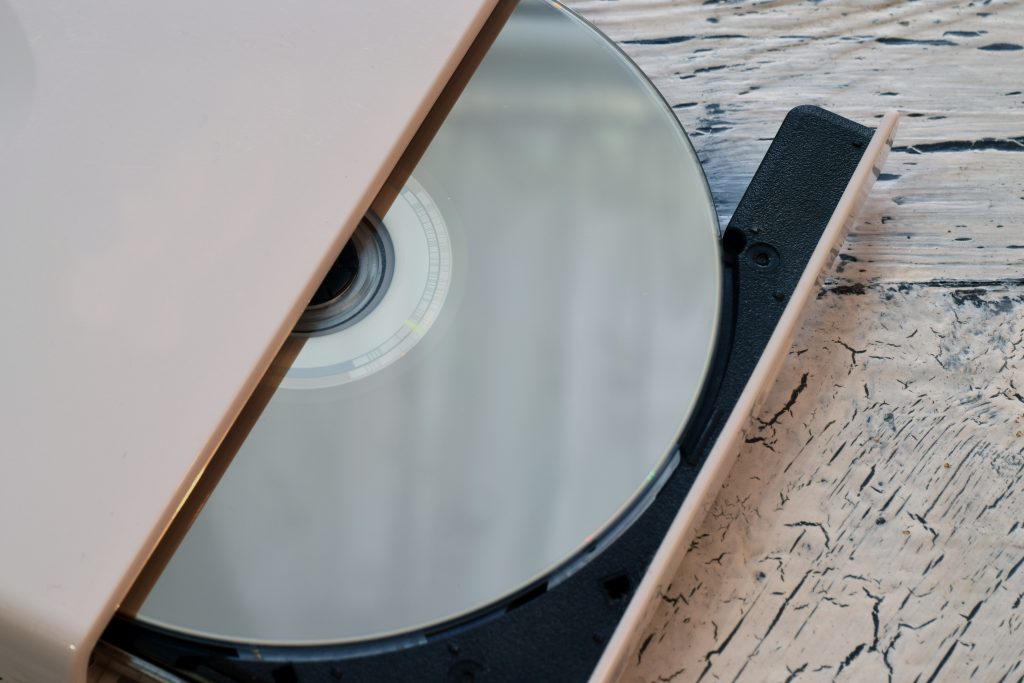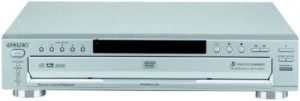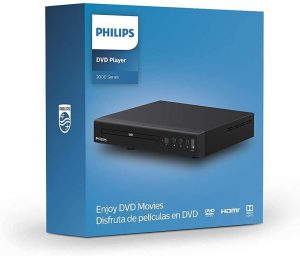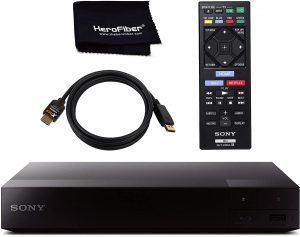Home>Technology>Home Entertainment Systems>DVD Player In 2022: Do You Still Need One?


Home Entertainment Systems
DVD Player In 2022: Do You Still Need One?
Modified: December 6, 2023
Move aside, Netflix: these shiny DVD player choices offer all-in-one portability, reliability and premium quality. "Old school" is the way to go!
(Many of the links in this article redirect to a specific reviewed product. Your purchase of these products through affiliate links helps to generate commission for Storables.com, at no extra cost. Learn more)
What is a DVD Player?
A DVD player is a device that plays DVDs and is very similar to a CD player. A DVD player decodes MPEG-2 encoded movies, turning it into a standard composite video signal. A DVD player also decodes the audio stream and sends it to a Dolby decoder where it is amplified and sent to the speakers. The cost of a basic DVD player today starts from $50 and can go into the hundreds if you’re after more features such as a DVD recording feature.
Read more: How To Connect A DVD Player To A Projector
Types of DVD Players
When selecting a DVD player, there are many features to consider. USB reproduction and Dolby Audio support are just two features that can make your whole DVD player experience much more enjoyable. Although they are not essential, they can make a drastic impact and completely change the whole multimedia experience. It’s important to do a bit of research and see what type of benefits certain features bring to a DVD player prior to purchasing one.
DVD players are, before anything else, made to reproduce audio CDs and DVDs, however, there are many models out there that support AVI, Xivid, WMA, and other video and audio formats. The more different outputs available, the more better connection options there will be. There are also many DVD players (e.g. DVD player windows 10) that work with your computers.
All in One DVD Player
An All in One DVD Player will allow you to record your favorite TV shows if you simply don’t have the time to watch it during the day. Additionally, it also allows you to play your CDs in your DVD player.
Multiple Capacity DVD Player
Some DVD players come with multiple disc capacity which is a great function to have when you’re having a party and would like to keep the music playing for hours. This function also helps you to save time on loading and unloading DVDs. Just load a few of your favorite movies into one disc and sit back and relax.
Portable DVD Player
Traveling a lot? You may want to consider getting a portable DVD player. Though a portable DVD player may be small in size and is limited in terms of functionality, it serves its purpose of playing your movie or TV show on the go.
Read more: How To Connect A DVD Player To Home Theater
Region-Free DVD Player
A region-free DVD player will play DVD discs from anywhere in the world including Regions 0 through 8. They are compatible with Pal, NTSC, and Secam DVD discs. Most models will also convert to Pal/NTSC/Secam output so you can play foreign movies on any TV without using an external video converter. A region-free player is an excellent investment for fans of foreign films and TV shows.
Smart DVD Player
There are many new Smart DVD players and home theatres today that can use the Internet to stream videos, music, news and more, plus download apps that you can typically find with a Smart TV.
Most households today already have a wireless network, so it’s important to choose a model that has built-in WiFi. It’s important to note that some manufacturers have models that say ‘Wi-Fi ready’, however, you will need to buy an adapter to allow it to have Wi-Fi capabilities. You’d also want to choose a model that has the ability to use Bluetooth compatible input devices. This will make using the web browser and many of the interactive applications much easier.
You can also use Bluetooth connect your smartphone to show pictures and movies right from your phone. Also, if you have an SD card camera or camcorder, then a USB media port can allow you to show your latest vacation clips or pictures instantly.
Blu-ray DVD Player
A Blu-ray DVD player is a great and affordable option to complement HD or 4K Ultra HD TV and home theater systems. In addition to playing Blu-ray discs, these players can do a lot more.
All Blu-ray disc players (except for a couple of earlier models) also play DVDs and CDs. Most players can also access audio and video content streamed from the internet (such as DVD players with Netflix) or local home network (such as PCs and media servers), as well as any content stored on compatible USB devices (such as flash drives).
Not only can Blu-ray disc players play DVDs but the visual display will look a lot better as Blu-ray players have video upscaling capabilities. Although DVDs will not look as good as actual Blu-ray discs, upscaling still provides an obvious improvement in terms of viewing.

In a similar manner as a DVD player, a Blu-ray DVD player also has a region coding and copy protection system. This means that players sold in specific regions of the world will adhere to a specific region code.
Regular Blu-ray players are a great match for high-definition televisions as they offer the best 1080p picture quality available. Most even have built-in WiFi for an easy connection to your wireless network. For movies and TV shows on the go, there are still portable players with rechargeable batteries – Some models even come with AC and car battery adapters as well.
4K Ultra HD Blu-ray DVD Player
A 4K Ultra HD Blu-ray player is the way to go if you have (or plan to buy) a 4K UHD TV. These players offer the best picture quality you can get today with 4K resolution, which is four times more compared to a standard Blu-ray player. These players also support a wider range of colors and have high dynamic range (HDR) capability, which can greatly improve the contrast between the brightest and darkest of images. In addition to playing 4K Ultra HD Blu-ray discs, Ultra HD players can also play regular Blu-ray discs as well as DVDs and CDs. Most can also connect to streaming video services, such as Amazon Prime and Netflix that offer 4K content.
All 4K Ultra HD Blu-ray players support the HDR10 high dynamic range format, however, some now also support another HDR format called Dolby Vision. Your TV will need to have the ability to support Dolby Vision in order for this functionality to work.
In addition to playing 4K Ultra HD Blu-ray discs, all Ultra Blu-ray players will also upconvert standard HD Blu-rays to quasi-4K resolution, which is something the TV can do as well.
Benefits of Having a DVD Player

Even though the term ‘Netflix and Chill’ is a thing, there are still a lot of people out there who would much rather watch a Blu-ray film rather than streaming a movie from Netflix or any of the other popular streaming services. There are also a lot of people out there who are extremely proud of their DVD collection that they have garnered over the years and would not like to just throw them away.
There’s Still a Need for DVD Services
It is actually known that though physical media sales have seen a decline while streaming revenues rise, some people still use Netflix’s DVD service. Their reasons for doing so may vary and in some cases probably has a lot to do with the quality of their Internet connection, however, by opting for Netflix’s DVD service, they get a number of benefits. These benefits include access to a larger library of content than what’s available on Netflix’s streaming service. The licensing for the physical renting of DVDs and Blu-ray discs is significantly simpler than the licensing for adding the same titles to a streaming library, and the most recent releases are often only available on DVD, not on the streaming service. However, an even bigger benefit is the video quality users will get if they opted for a Blu-ray disc instead of finding something to stream online.
Better Video Quality
If you’re used to streaming all of your favorite movies and TV shows instead of watching them on DVD or Blu-ray, you may not realize that you’re missing out on the best video quality. The video and audio quality of a Blu-ray disc is much higher than what you can stream online. That’s because even though a user can stream a movie at the same resolution that they’d get when watching it on Blu-ray, the streaming service needs to use more compression to deliver the movie than the Blu-ray disc would. Since it has to compress the file enough to send it at a bitrate that’s equal to or lower than the user’s broadband speed. Netflix as an example has to optimize its Super HD 1080p streaming service for internet speeds as low as 7 Mbps, so, ultimately, you’d get a better picture and audio quality just by watching a Blu-ray movie instead of streaming it.
Poor Internet Connection
![]()
Another consideration to bear in mind is how your internet service impacts your streaming habit. If it’s important for you to ‘binge-watch’ in front of the TV despite network slowdowns and outages, then you’ll probably want to keep your DVD or Blu-ray player as you may really need it. One of the main benefits of having a DVD player is that you can still watch all your favorite films and TV shows even if your internet is down. This will help explain why many of Netflix’s DVD service subscribers live in rural areas with lackluster internet access and even some that don’t have internet service at all.
Even if you do have a reliable connection, your network may not always be moving fast enough to stream an entire movie without any annoying lags. Also, if you’re approaching your data limit for the month but would still like to zone out in front of your favorite movie and/or TV show, it can pay to have a way to watch a DVD or Blu-ray instead of trying to stream the title for the tenth time (we’ve all been there).
Additionally, as 4K content becomes available on Netflix, Amazon, and other streaming services, users will need to think more about how fast their internet service needs to be to stream that type of content. As real-world broadband speeds fluctuate, users will need a connection of somewhere between 25 – 50 Mbps in order to stream a movie at 4K quality.
Read also: 8 Amazing DVD Player For Television For 2025
Blu-ray vs DVD Player
The key difference between a Blu-ray and a DVD player is that DVDs have a standard definition of 480i resolution format, while Blu-ray/HD-DVD discs can be up to 1080p HDTV quality. The extra resolution in Blu-ray discs make the images look sharper, more detailed and more realistic. Therefore, you’d expect that the Blu-ray version of a film will be shown in much higher quality – up to four times that of a DVD.
Although Blu-ray discs look exactly the same as DVDs in terms of shape and size, however, there are many differences between the two, including storage capacity and image resolution.
Storage Capacity
Storage capacity is measured in gigabytes (GB) – The more GBs the disc has, the more information it can hold.
- DVDs can store about 4.7GB of data, which is about two hours worth of movie. Double layer DVDs, however, can store twice the amount of data at 8.7GB – This equals about four hours of movie.
- Blu-ray or single layer Blu-ray discs store approximately 25GB of data, this equals about two hours of high definition information or 13 hours of standard definition information. Double layer Blu-ray discs can hold about 50GB equaling about four and a half hours of high definition information or 26 hours in standard definition.
Image Resolution
Image resolution is measured by the number of vertical lines times the number of horizontal lines of light in a picture. It is represented by the number of horizontal lines going across the screen such as 480, 720 or 1080. The higher the number, the higher the resolution and the more detailed the picture will be.
- DVD: Almost all DVDs have a standard definition resolution of 480 or enhanced definition resolution of 520. These resolutions look great on a standard TV utilizing all available pixels on the screen, however, if blown up to accommodate a widescreen HDTV, the picture may look grainy. Although a DVD can store high definition data, it would only fit about 30 minutes maximum.
- Blu-ray: Blu-ray was designed for high definition 1080 display. Since they can store 25GB of data, you can fit an entire HD movie on a single layer disc.
The DVD Player: Still A Winner In 2020
As illustrated by the points above, a DVD player is still very much useful to have around for its stability, portability and image resolution, among several other factors. No need to hesitate when it comes to this multi-functional data storage product: go grab yours today.
Was this page helpful?
At Storables.com, we guarantee accurate and reliable information. Our content, validated by Expert Board Contributors, is crafted following stringent Editorial Policies. We're committed to providing you with well-researched, expert-backed insights for all your informational needs.































0 thoughts on “DVD Player In 2022: Do You Still Need One?”